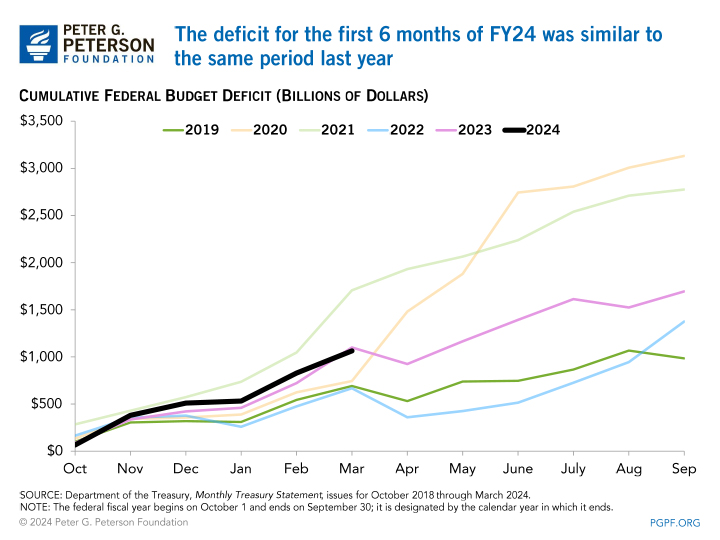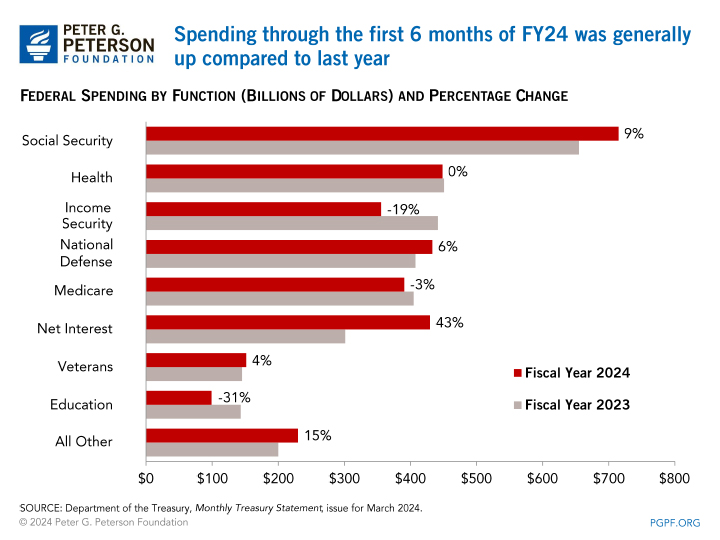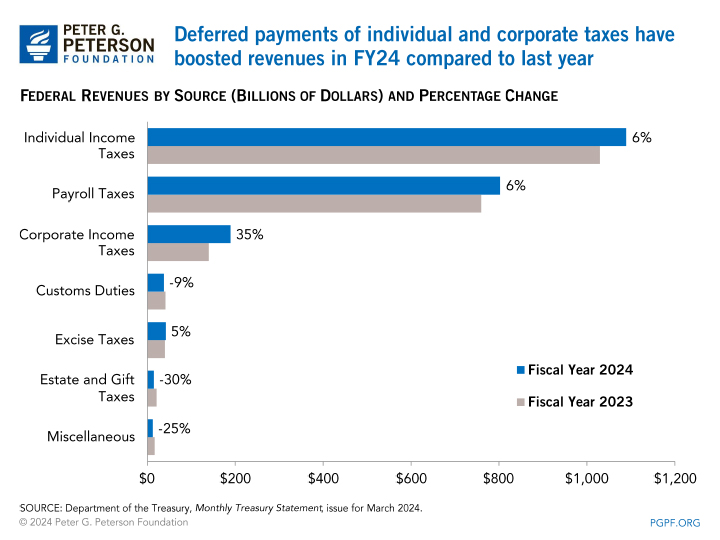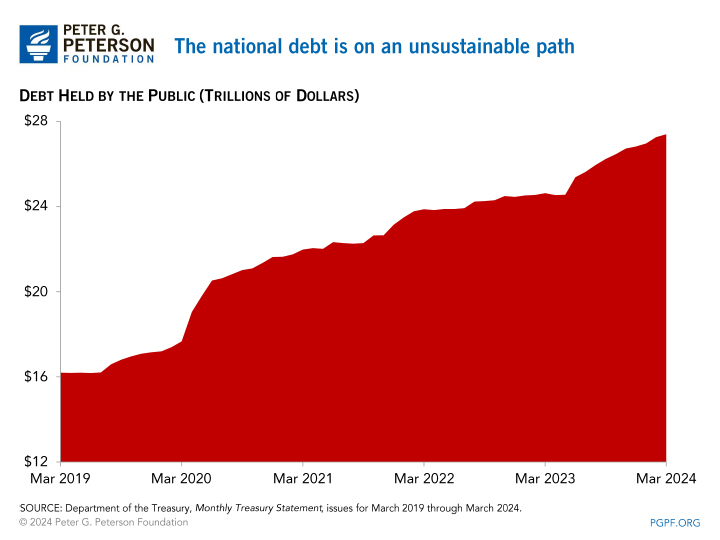You are here
Federal Deficit and Debt: March 2024
Every month the U.S. Treasury releases data on the federal budget, including the current deficit. The following contains budget data for March 2024, the sixth month of fiscal year (FY) 2024.
Current Federal Deficit

- Federal Budget Deficit for March 2024: $236 billion
- Federal Budget Deficit for March 2023: $378 billion
The federal government ran a deficit of $236 billion in March 2024 — $142 billion less than the deficit of $378 billion that was recorded in March 2023. It is important to note that certain payments were shifted into March 2023 due to April 1, 2023, falling on a weekend. Adjusting for the effects of that timing shift, the March 2024 deficit was $73 billion less than the same month last year.
Spending in March 2024 was $569 billion, $123 billion less than in March last year, although much of that reduction can be attributed to the timing shift. Adjusting for that timing effect, outlays were down $49 billion compared to March 2023. The primary driver was a $30 billion decrease in spending by the Federal Deposit Insurance Corporation. In March 2023, the agency spent $27 billion to cover the deposits of two failed banks, while this March, it recorded net receipts of $3 billion. Spending by the Department of Education (DoE) also decreased -- by $29 billion -- because costs associated with the pause in repayments of student loans were recorded last March. Those and other decreases in spending were partially offset by a $13 billion increase in net interest. Revenues in March 2024 were $19 billion above collections from a year ago, mainly due to a reduction in refunds of individual income taxes ($12 billion more than in March 2023) as well as increased collections of income and payroll taxes ($7 billion).
Cumulative Federal Deficit

- Cumulative FY24 Deficit: $1.1 trillion
- Cumulative FY23 Deficit: $1.1 trillion
This year’s cumulative deficit is $36 billion below last year’s level. However, because October 1 fell on a weekend in both calendar years 2022 and 2023, certain federal payments were shifted into the previous fiscal year in both FY23 and FY24. Without those effects, and the impact of April 1, 2023, falling on a weekend, the deficit for FY24 through the end of March would be $47 billion above last year’s corresponding total.
For the first six months of FY24, total outlays were $3.3 trillion, $103 billion higher than the same period in the previous year. Adjusting for timing shifts, spending was $186 billion above the same period last year. Two areas of the budget have experienced rapid increases so far this year. Net interest has grown by $128 billion (43 percent) relative to the first six months of last fiscal year, mostly due to higher interest rates; spending for Social Security benefits has risen by $60 billion (9 percent) because of cost-of-living adjustments and an increased number of beneficiaries. In addition, spending on Medicare, defense, and deposit insurance increased significantly in the first six months of the fiscal year. Partially offsetting those increases was a $44 billion decrease in spending by the DoE because some transactions related to the student loan program were recorded in FY23 (but not in FY24). Another category that decreased significantly was spending by the Pension Benefit Guaranty Corporation because certain one-time payments were made to pension plans in FY23 but not FY24 ($35 billion). Other categories of outlays that decreased were related to the government’s response to the COVID-19 pandemic ($26 billion) and spending associated with the end of emergency funding for the Supplemental Nutrition Assistance Program ($24 billion).

Total revenues increased by $140 billion in the first six months of FY24 compared to the previous year. The main driver was increased amounts withheld from workers’ paychecks through the first six months of FY23 ($45 billion). Collections of individual and corporate income taxes have also been much higher in FY24 than through the same period in FY23, driven by deferred payments of individual and corporate income taxes for taxpayers in locations that suffered natural disasters.

National Debt

- Debt Held by the Public at the end of March 2024: $27.4 trillion
- Debt Held by the Public at the end of March 2023: $24.6 trillion
Despite a healthy economy, spending has been rapidly outpacing revenue collection. The unsustainable upward trajectory of deficits and debt argues for bipartisan solutions to improve the country’s fiscal outlook.
